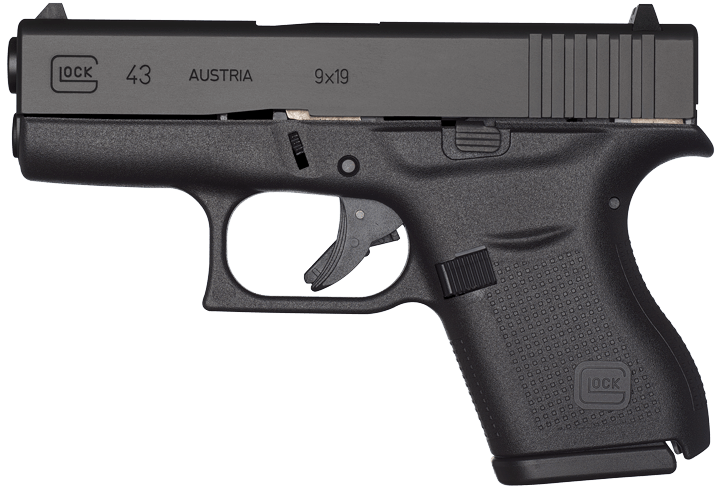Phase 4 — Mastering the Gentleman Spy Skill Set
Lesson 2 — Guns and Shooting
LESSON 2: Guns and Shooting
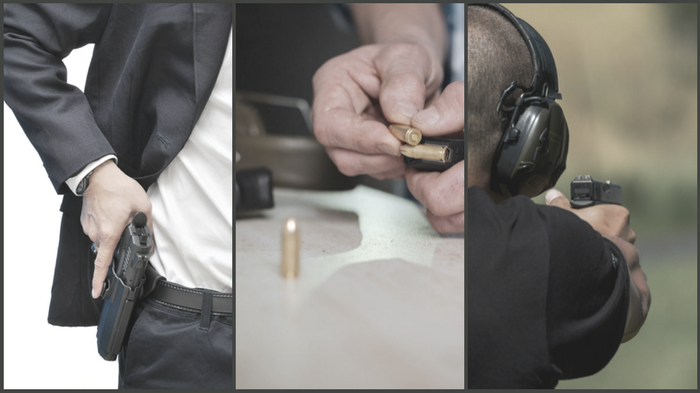
Walther PPK. 7.65mm. Only three men I know use such a gun...
I believe I've killed two of them.
~Valentine Zukovsky to James Bond in GoldenEye
When we think of the gentleman spy, we think of James Bond. 007 and guns have gone together since Ian Fleming wrote Casino Royale in 1953.
Living like a Gentleman Spy means being good with a gun.
Some background is in order. James Bond’s first gun wasn't the PPK he carries today; it was a Beretta 418 (now known as the Beretta Tomcat). A reader, Geoffrey Boothroyd, wrote Ian Fleming and stated “I dislike a man who comes into contact with all sorts of formidable people using a .25 Beretta. This sort of gun is really a lady’s gun, and not a really nice lady at that.” Boothroyd suggested a revolver, but Fleming wanted an automatic, so they settled on the 7.65mm (.32 auto) Walther PPK.
As times have changed, so have the spy’s weapons, in both the books and the movies. Bond has used the Beretta, Walther PPKs and P99s, ASP 9mm, Browning Hi-Power, and Sig 226 as his personal weapon. An opportunist, he will use whatever becomes available, and has been seen with revolvers, pistols, rifles, carbines, submachine guns, and more.
This isn't applicable to 007 alone; real life spies around the world are trained on many different guns and will use whatever they have at their disposal, be it a Glock or AK, Browning Hi-Power, AXMC, PKM, or M4. You don't need to buy dozens of different weapons, but you should have a basic working knowledge of the pistols and rifles that will serve you well in many different roles.
Before going any further, you need to know the firearms safety ground rules:
- All guns are always loaded. Even if you know for a fact that it’s unloaded, treat it as if it is loaded; follow the rest of the rules.
- Never point a gun at anything you are not willing to destroy (or anyone you are not willing to kill).
- Keep your finger off the trigger unless your sights are on target. A modern pistol will not fire unless you pull the trigger. It didn’t “just go off” — you fired it.
- Be sure of your target, and what is beyond it. Even in police shootings, only 17 to 40 percent of the shots hit their target. That means that the other 83 percent went past the target into whatever was behind them. Innocent bystanders, through the wall into the house next door, etc. Know what you’re shooting at.
Pistols
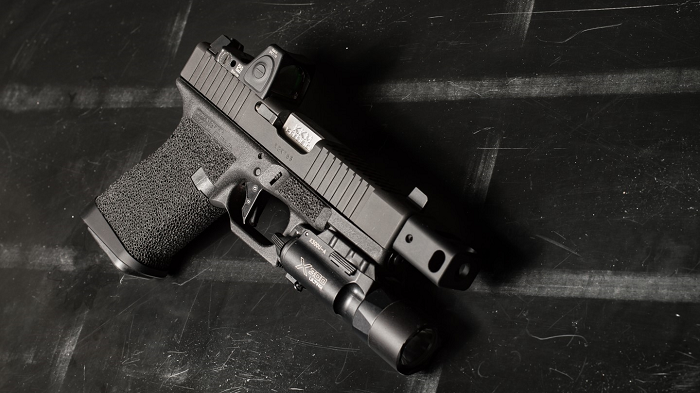
The pistol is the one firearm you can carry with you at all times. Not just part of living the gentleman spy lifestyle, carrying a pistol is essential for ensuring your own personal security.
For the James Bond purist or the fan who wants to have what 007 himself used, it’s likely that only the Walther PPK will satisfy your desires. If that’s the case, any gun store that sells Walthers will be able to get you squared away.
For those that take their security more seriously than the desire to have “007’s gun,” there are additional factors to consider. Bond’s Beretta didn’t cut it, so he upgraded to the PPK that he’s been seen with ever since. That was in 1958. Handguns have come a long way since then.
Modern auto-pistols will do everything the PPK will do, for less money, more reliably, with a full-power caliber. If you take your life and personal security seriously, you will be doing yourself a favor to look at the following:
Glock
Introduced in 1982 and increasing in popularity ever since, Glocks are used in some capacity by almost every advanced military in the world and are the most popular weapons among police officers, competitors, and armed civilians worldwide.
Glocks are the current issue pistols for the United States Special Operations Command (Rangers, Special Forces, SEALs, Marine Raiders), the FBI, Secret Service, British Armed Forces, Israeli Defense Forces, New Zealand Defense Forces, Russian FSB, MVD, Special Forces, and countless other military, police, and counter-terrorism units worldwide.
The most popular handgun in the world by a large margin, no matter where you are, if you didn't have a pistol and needed one, you could find a Glock.

The Glock 19 is the quintessential “one gun fits all.” It’s big enough to handle any situation that can be handled by a handgun, yet small enough for most people to conceal in normal clothes. From a bone stock concealed carry or nightstand gun to an uber-customized Roland Special (image above) or Glock PDW, the 19 can be pressed into service in any role that a handgun can handle, plus many roles traditionally reserved for something more powerful.
The only drawback to the Glock is that the stock plastic sights are terrible and must be replaced with quality metal sights.
Aftermarket support for these pistols is superb. There are so many upgrades available that it's not only possible, but common to build a "Glock" pistol without a single Glock part in it.
Bottom line: the Glock 19 is the pistol against which all others are judged. It should be your default choice unless you have a specific and pressing need to choose a different weapon.
SIG Sauer
SIG Pistols have always been good, but the introduction of the P320 and P365 catapulted SIG into the #2 place behind Glock.
The P320 beat out Glock, S&W, FN, and Beretta as the US Army's new service pistol (designated the M17 and M18), with the Air Force, Navy, and Marine Corps quickly following suit. US Immigration and Customs Enforcement; the Danish, Canadian, and Australian militaries; multiple state and local police departments; and others have adopted the P320, while the P365 is fast becoming the concealed carry pistol of choice for many.

The SIG Sauer P320 is a modular design with only the trigger group being a serialized part. Different grips, slides, barrels, and more can be purchased to transform the P320 from a small and light CCW weapon to a full-sized fighting pistol or even suppressed PDW and everything in-between.
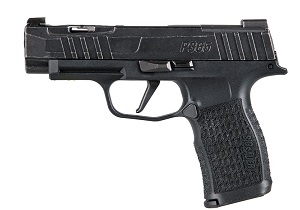
Designed as the ultimate concealed carry pistol, the SIG P365 is SIG’s answer to the Glock 43 and S&W M&P Shield. Similar in size to the Walther PPK, its higher capacity, better trigger, and native red dot capability make it arguably the best concealed carry pistol ever made.
The only drawback to the SIG options is that they aren't as prolific as the Glock, but that gap will continue to close as the aftermarket for SIG matures.
If you don't want a Glock, the P320 and/or P365 should be your second choice.
Everything Else
While the Glock and SIG are the most popular — for good reasons — there are dozens of other weapons that can fit the bill, so feel free to test things out and see what fits you best. But go into any other purchase knowing that your choices in holsters, sights, lights, and other aftermarket support will be limited in comparison.
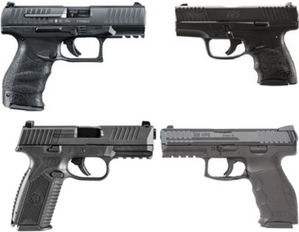
The Smith&Wesson M&P series of pistols used to be in second place behind Glock and is still the second- or third-most-used police pistol in the US. They're excellent pistols, but the large-scale federal and military adoption of the SIG dropped S&W into the "everything else" category.
Recently adopted by the LAPD, the FN 509 is one of the best optics-ready pistols available, along with the Walther PDP.
The Heckler & Koch P30 or VP9 are both excellent.
For those that want to stick with 007's Walther but want something modern, the PDP is perhaps the best striker-fired pistol on the market today.
Just as there are good choices, there are many less than ideal — and flat out bad — choices.
There's a reason that Glock and SIG dominate the market.
Competitors like S&W, FN, HK, and Walther make excellent pistols but they don't have the market share or aftermarket support of the big ones. These are great guns — as good or better than Glock or SIG — but they aren't the best choice unless you have a specific reason. If you or your friends and family are already standardized on something like the M&P or FN (usually because they're what somebody is issued at work), then go ahead. Otherwise, stick with Glock or SIG.
Manufacturers like Beretta, CZ, Kahr, Ruger, and Springfield Armory are just okay. They're fine guns, but they're not good enough in any regard to justify choosing them over the top players.
Others range from mediocre to terrible. Don't try to save a few bucks or be cool and different by getting something weird like a Hi-Point, a Desert Eagle, or Taurus Judge.
Purchase used from one of the big players or wait until you can buy a quality firearm.
As you start going into gun stores you will almost always run into all sorts of bad information. Whether the salesman is trying to sell you an airweight revolver for concealed carry or convince you to get a .45, .40, or .357 instead of a 9mm, there is a considerable amount of misinformation, myths, and flat out lies that are perpetuated by those who should know better.
There can be exceptions to every rule and there may be a place exotic guns, custom 1911's, revolvers, and other specialty pieces in your life, but these are the exceptions, not the rule, and anybody who tells you different is either ill informed, outdated, or trying to sell you something.
Stick with the tried and true formulas that have worked for military, law enforcement, and armed civilians for decades:
- A modern auto-pistol from a major manufacturer,
- Chambered in 9mm,
- Loaded with quality hollow-point ammunition.
A note on ammunition: Any cheap ammo is fine for training and plinking, but for defensive use or concealed carry you should load your pistol with quality hollow-point ammunition. Do not use gimmicky bullshit like R.I.P. or zombie-branded ammo.
Federal HST, Hornady Critical Duty or Critical Defense, Remington Golden Saber, Speer Gold Dot, and Winchester Ranger are the "Big 5." Every major police force or federal agency uses one of these 5 rounds. Pick the one that functions reliably and is most accurate in your weapon.
Rifles/Carbines/SMGs
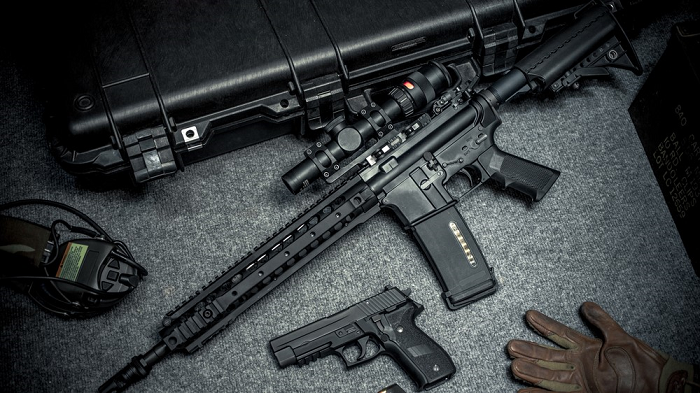
007 is only seldom shown with a rifle or submachine gun (SMG), but it’s worth noting that any gentleman spy should be expert in these systems as well.
You probably won’t be carrying a loaded rifle everywhere you go, but it is legal and advisable to have one available at home and/or in your vehicle in most of the US.
Contrary to the fearmongering in the media and among many politicians, there is every reason for a civilian to have a semi-automatic rifle or carbine.
The same reasons these are preferred by soldiers, special operations, SWAT teams, and hostage rescue units worldwide is the same reason you want one: it is the best all-around weapon in a fight.
This is especially true of a fight in relatively close quarters like your home or property. The rifle is more accurate, easier to control, with less risk of over-penetration than either a handgun or shotgun. It is the best tool for the job.
The submachine guns that Bond uses, in recent times the HK MP5 or UMP, are extremely difficult for the average citizen to get a hold of, as are select-fire (fully automatic) assault rifles. They're not necessarily illegal to own, but the process to obtain them is onerous, expensive, time consuming, and not worth the effort for most people.
This leaves us with the prolific semi-automatic rifles and carbines. Often falsely derided as "assault weapons," these are entirely legal for most Americans (and many folks elsewhere in the world) to own.
The two primary variations are the American AR-15, the Russian AK-47, and their clones.
Dozens of other designs exist: the ACR, AK-12, AUG, FAL, M-14, MDR, Mini-14, SA80, SCAR, Sig 550, Tavor, and XCR, among many others, but their market share in total pales to what either the AR-15 or the AK-47 have individually.
Because the AR-15 and AK-47 are the most prolific, here’s how they break down:
AR-15

Based off Eugene Stoner’s AR-10 design from 1957 and in a process of constant refinement for almost 70 years, the AR-15 is currently the pinnacle of personal weapons technology.
Generally chambered in 5.56x45mm NATO, it is accurate, configurable to many missions, and reliable.
Versions are available in different calibers like .300 AAC Blackout, 6mm ARC, .224 Valkyrie, and 6.5 Grendel, as well as large-format “battle rifle,” "DMR," or “sniper” variants chambered in 7.62mm NATO, 6.5 Creedmoor, 6.8x51 (.277 Fury), and more.
Variants of the AR-15 are in current use with almost every western military. M-16, M-4, Mk12, Mk18, and M110 are just a few of the different configurations used in the United States. The Canadians and UK MOD use the C7, C8, and L129A1. Australia, New Zealand, Germany, and others use versions of the platform.
NOTE: The SIG MCX, while not technically part of the AR-family, shares a similar-enough form factor and manual of arms that it's also a good option. MCX variants in 5.56x45, .300 Blackout, and 6.8x51 are in use by the US Army, US Special Operations Command, UK Special Forces, Australian Defense Forces, and special mission units or national police forces in more than a dozen other countries.
From the Jungles of Vietnam, to killing Osama Bin Laden, to 20+ million American homes, the AR-15 and its variants has been defending the free world for 60 years and is only getting better.
AK-47

Designed by Mikhail Kalashnikov and adopted by the Russian military in 1947.
Originally chambered for the 7.62×39 round and since adapted for the 5.45×39 as the AK-74 as well as 7.62x54, 5.56x45, and 7.62x51 rounds.
Modernized versions including the AK-12 and AK-15 are current issue weapons in Russia, while other AK variants are issued and used throughout eastern Europe, Africa, and Asia.
It has the reputation as the most reliable assault rifle around, for good reason, and with high-quality, modern ammunition, is capable of more than acceptable accuracy.
Rifle Choice and Configuration
Assuming you live in North America, Europe, Australia, or New Zealand, your best bet is an AR variant from a quality manufacturer.
It is most widely used semi-automatic rifle platform in the English-speaking world. AR's are reliable, accurate, easy to use, and highly configurable for almost any role from home defense to hunting. Ammunition, magazines, accessories, and spare parts are inexpensive and readily available.
For an AR-15 platform rifle, Colt, Fabrique Nationale d'Herstal (FN), Knight's Armament (KAC), Heckler & Koch (HK), Lewis Machine & Tool (LMT), and SIG Sauer all produce quality rifles for military contracts. Bravo Company Manufacturing (BCM), Daniel Defense, Hodge Defense, LaRue Tactical, Noveske Rifleworks, Primary Weapons Systems (PWS), and others produce exceptional rifles that have been widely adopted by law enforcement and civilians.
If you live in an area where the AK is more common, that might be a better choice as your primary rifle; your choices may be dictated by what you can acquire where you live.
For those who travel extensively — especially to former Soviet Bloc countries, Africa, Asia, and the Middle East — it makes sense to at least be very familiar with its operation.
If you're looking to purchase an AK, look at the rifles imported or manufactured by Arsenal, Century, Kalashnikov-USA, or smaller shops like Rifle Dynamics or Krebs Customs that specialize in the AK platform.
Regardless of which platform and manufacturer you choose to purchase, they should be set up similarly.
A modern fighting rifle needs three things: a sling, an optic, and a light.

The sling should be an adjustable two-point like the Magpul MS-1, Proctor Sling, VCAS, VTAC, or similar.
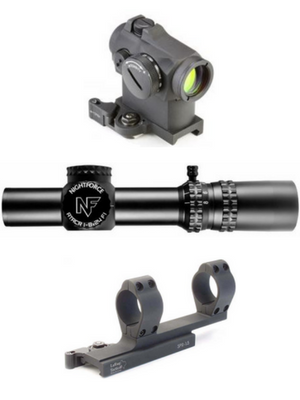
The best bets for optics are red-dot sights like an Aimpoint or EOTech for home defense, or low-power variables like 1–6x or 1–10x for all-around or longer range work. Low-power variables are becoming better and more popular with models from Bushnell, Leupold, Nightforce, Swarovski, Trijicon, and Vortex now dominating 3-gun competitions.
Scopes need mounts, and on a fighting carbine, a quick detach mount is a good idea (though arguably not the requirement it was a decade or two ago). Badger Ordinance, Bobro Engineering, LaRue Tactical, Scalarworks, and others make good choices.
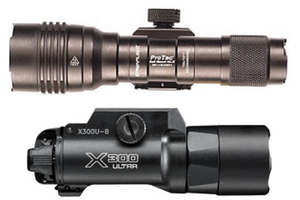
The light should be something like the Surefire X-series or Scout, Streamlight TLR or ProTac, or Inforce WML.
Whether you’re protecting your home, carrying your rifle through the woods, or just having fun at the range, this is the perfect all-around setup.
Training
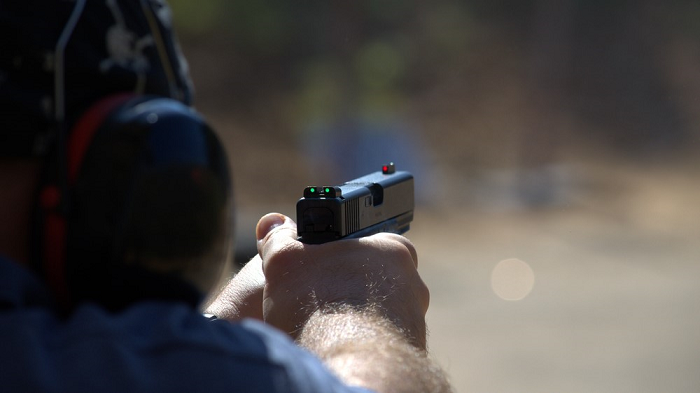
Bond, Bourne, and Bauer didn’t magically become expert marksmen, they trained for years to get there. You should too.
Many men automatically believe they are expert marksmen. Even if you grew up around guns and consider yourself a good shot, if you haven’t had recent formal training, you owe it to yourself and those around you to obtain the best training you can.
The best place to start is to find an NRA basic pistol instructor and attend a course. For those outside the USA, find a local firearms club and join it. While taking the course, you can talk to your instructor about concealed carry classes, and you can probably try different types of pistols to see what works best for you.
As with the pistol, you should attend at least a basic rifle course. The NRA courses are again highly suggested, as are the “Appleseed shoots” put on by the Revolutionary War Veterans Association.
The NRA or other basic courses are just that: basic. These are the bare minimum training you should have, and you should do everything in your power to seek more training and train as often as you can.
Attending defensive/practical/combative pistol and rifle training is a very good idea. These courses will have you drawing your pistol from concealment, using your rifle and sling as designed, and shooting from multiple positions. These types of courses will hone your skills in an environment that is much closer to real-world combat than the introductory course you took in a slow, controlled environment.
Defensive/practical/combative pistol and rifle courses are everywhere now. Almost any range will offer some type of course or will be able to point you in the right direction. Alternatively, you can travel to attend courses like those offered by Constellis (formerly Blackwater), Costa Ludus, Gunsite, Haley Strategic, Kyle Defoor, Rifles Only, Rogers Shooting School, Sentinel Concepts,the Sig Sauer Academy, Suarez International, Thunder Ranch, and other top-rated trainers.
After your training, regular practice is essential. Even when you can’t get to the range every week, daily and/or weekly dry-fire and weapons manipulation practice at home will develop the subconscious gun-handling skills required to be truly proficient with your weapon(s) of choice.
Concealed Carry
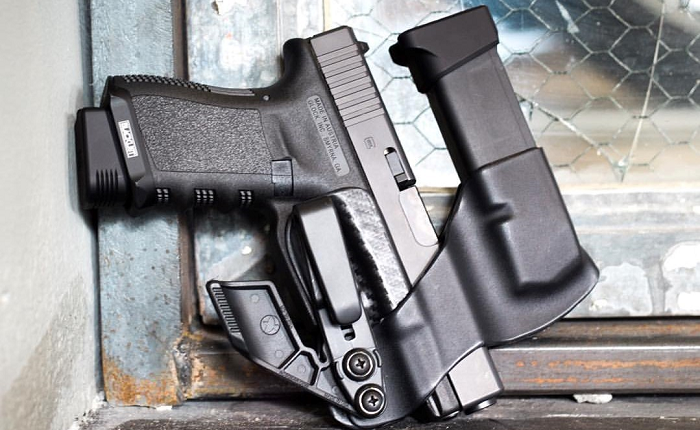
After purchasing your handgun and attending a basic pistol course, it’s time to get your concealed carry permit.
Concealed carry of a handgun is legal in every state in America, although there are areas where it is very difficult (bordering on impossible without the right connections). Even if you live in one of those states, it’s possible to go to Florida, Pennsylvania, Texas, or one of the other states that issue non-resident permits and get one that will allow you to carry as you travel throughout America.
Check out USA Carry and the US Concealed Carry Association (USCCA) for more information on your state laws and what other states will accept your permit once you receive it.
If you live in a may-issue state or city and find it difficult to obtain your concealed carry permit or license, you can always vote with your feet and move.
For those outside America, check your local laws. Many will be out of luck, but there are many areas of the world that allow people to carry firearms for personal defense.
Your CCW instructor will have more information regarding holster selection, legal methods of carry, and the ramifications if you have to use your handgun. Take the course, learn the basics, and report back.
A note about holster selection. Bond is always seen carrying in a shoulder holster underneath his suit. With the huge selection of high quality belt holsters for carry underneath a jacket, and inside the waistband holsters for carry under a t-shirt, the shoulder holster is not the method of choice and has not been for decades. It may look good on TV or the big screen, but not in real life.
Try out different holsters, see what fits and what feels good, and start living like a gentleman spy: armed.
PROGRAM
DOWNLOADS
 Guns and Shooting Checklist
Guns and Shooting ChecklistProtect yourself and your family the right way, the first time. From proper firearm selection to cleaning supplies, personal protection, and concealed carry holsters, this checklist includes everything you need to get started or step up your shooting game.
In the next lesson...
Living a life of adventure will eventually reward you with some cuts and bruises, if not much worse. Living like a gentleman spy means saving the day. Medical training, and the proper tools, may very likely save your life or somebody else's. Learn what you need to know.

